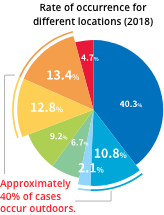Outdoor cooling
The Silky Fine Mist with a 6μm particle size effectively cools the air and your body through evaporative cooling, replicating the process of sweating.
Evaporative Cooling
The mist's evaporation removes heat from the air. The Silky Fine Mist provides efficient cooling due to its microscopic particle size.
Replicating the process of sweating
The mist's evaporation off your skin removes heat, directly cooling you in a comfortable way by replicating the process of sweating.
Global Warming & Heatstroke
Due to global warming, the average temperature in Tokyo has risen by 3.2 degrees Celsius over the last 100 years. This has increased the number of cases of fatal heatstroke. 40 % of these cases occur outdoors. As the temperature is expected to rise even further in the future, it is essential to take some countermeasures.
The SET* temperature scale is an effective way to measure the cooling effect.
SET*: "Standard new Effective Temperature".
SET* is a standard temperature scale that is used to represent the level of heat experienced by a person. In addition to ambient temperature, it also takes into account radiation, humidity, and wind factors. People can be heated by radiation directly from the sun as well as infrared radiation from hot objects. Humidity affects heat dissipation due to sweating, and wind affects heat dissipation due to convective heat transfer from the skin. In order to evaluate the temperature sensed by a person, it is necessary to consider all of these factors. The SET* temperature scale is calculated based on 6 factors. These consist of four environmental factors (temperature, humidity, wind speed, and radiation) as well as two human factors (clothing, metabolism). It is defined as the "equivalent temperature of an isothermal environment at 50 % RH in which a subject would have the same heat stress and thermoregulatory strain as in the actual test environment" and it is calculated by performing a heat balance analysis on a human body thermal model.
Fine mist is an efficient method for reducing the perceived temperature for those outdoors.
According to the Ministry of the Environment's "Guidelines for Countermeasures Against Urban Heat", a combination of heat countermeasures according to the particular location and local characteristics is the best method for lowering the perceived temperature (SET*).






